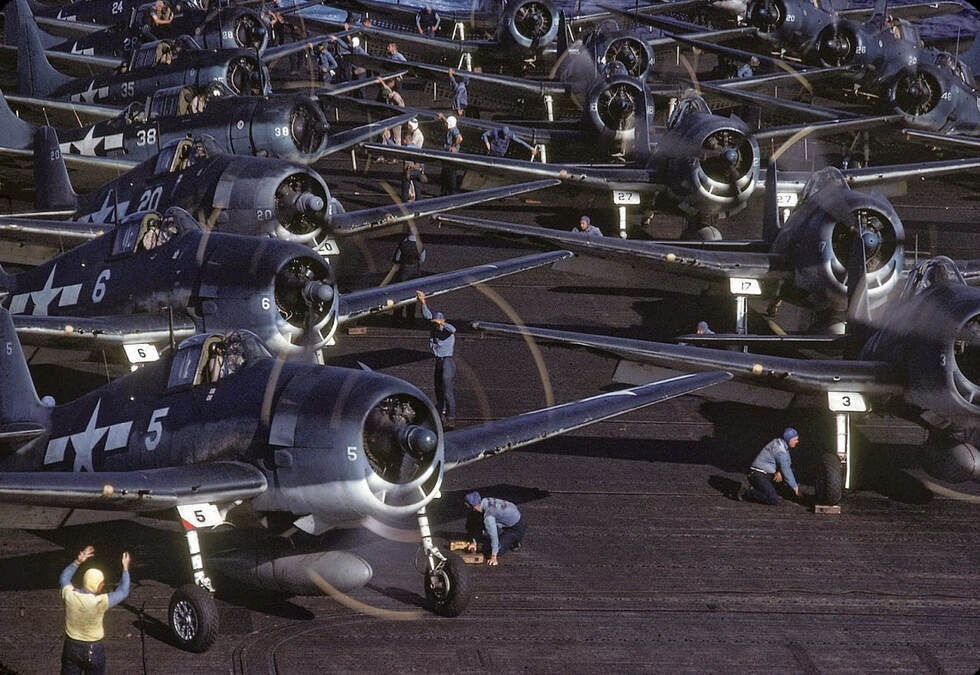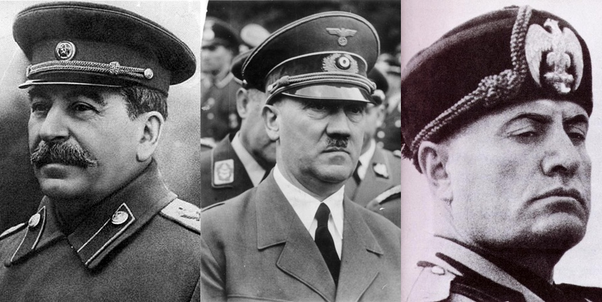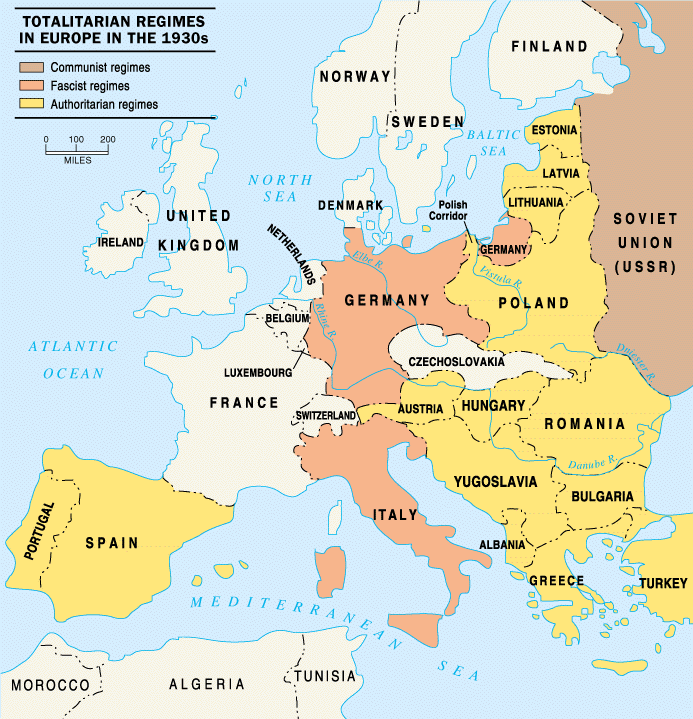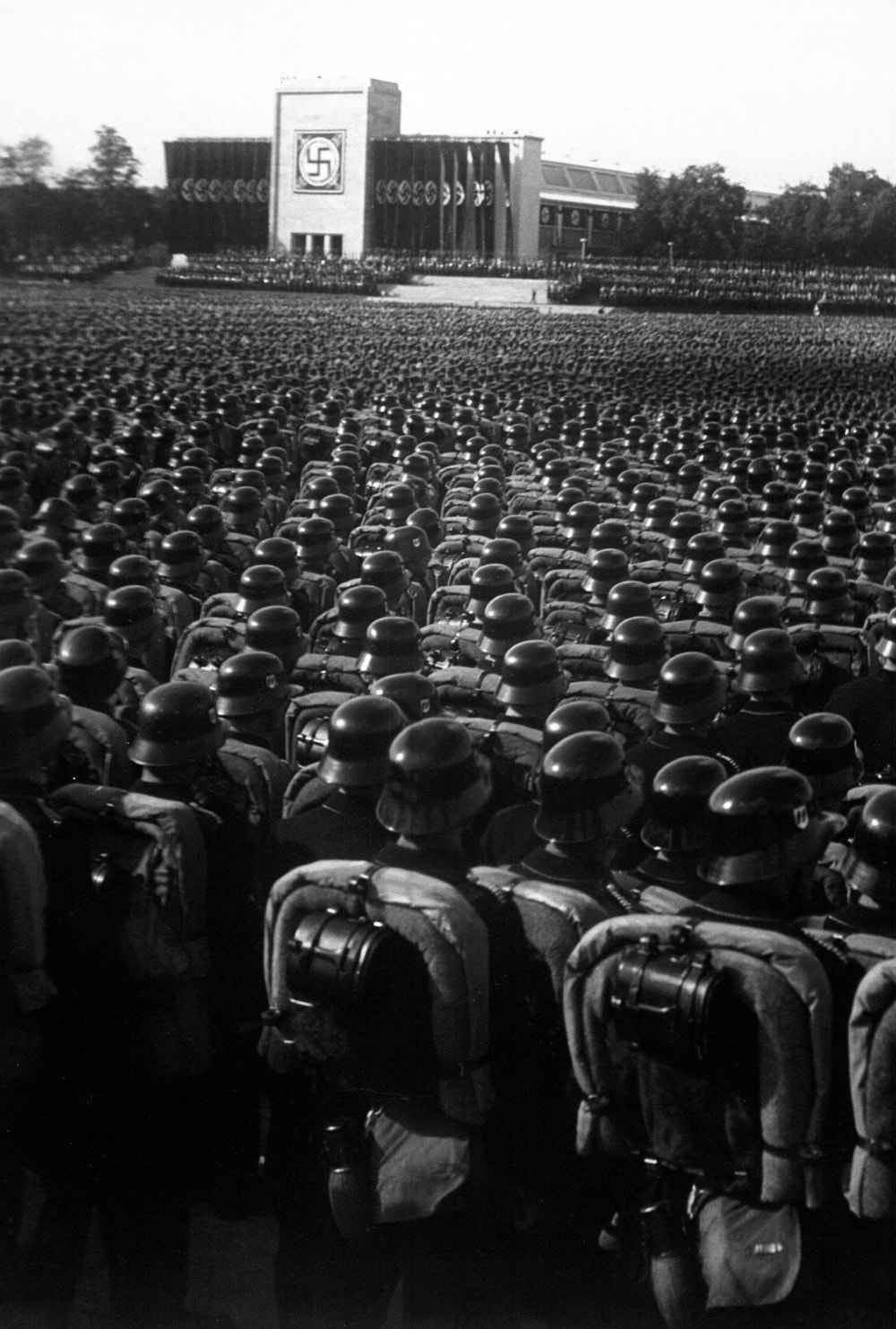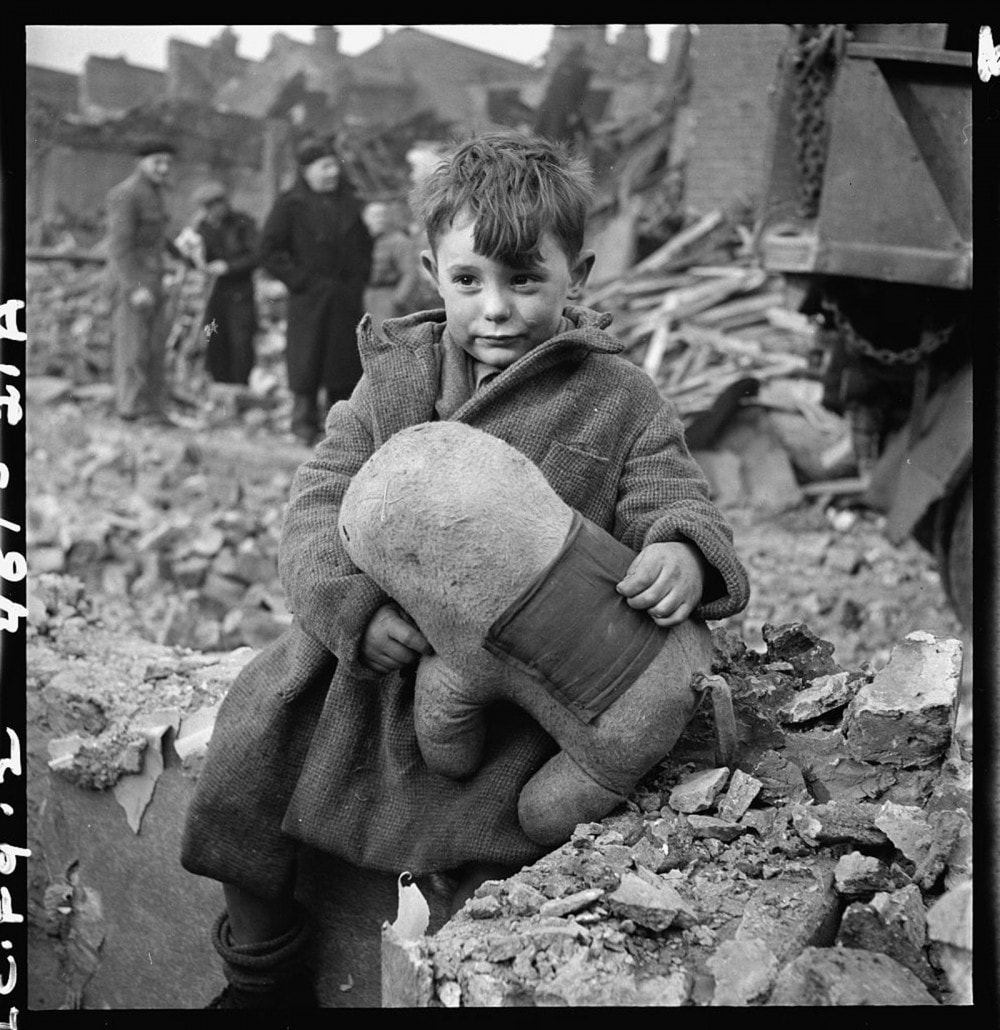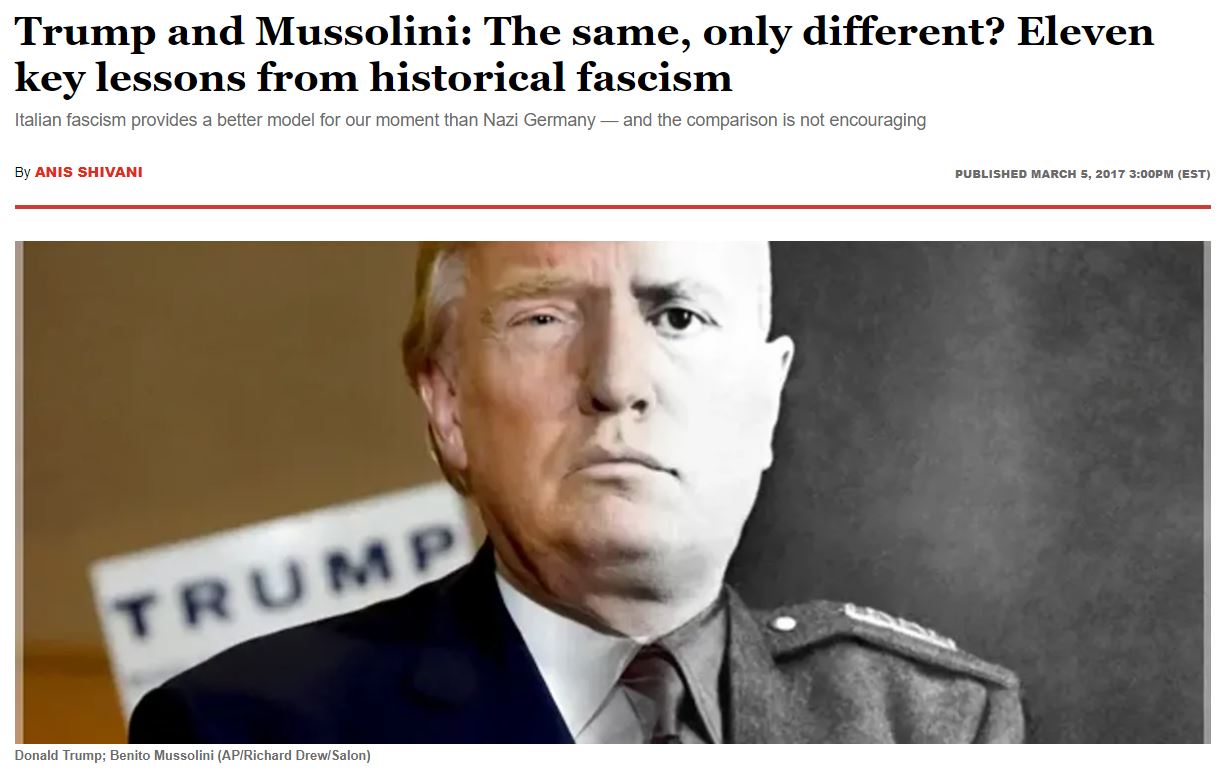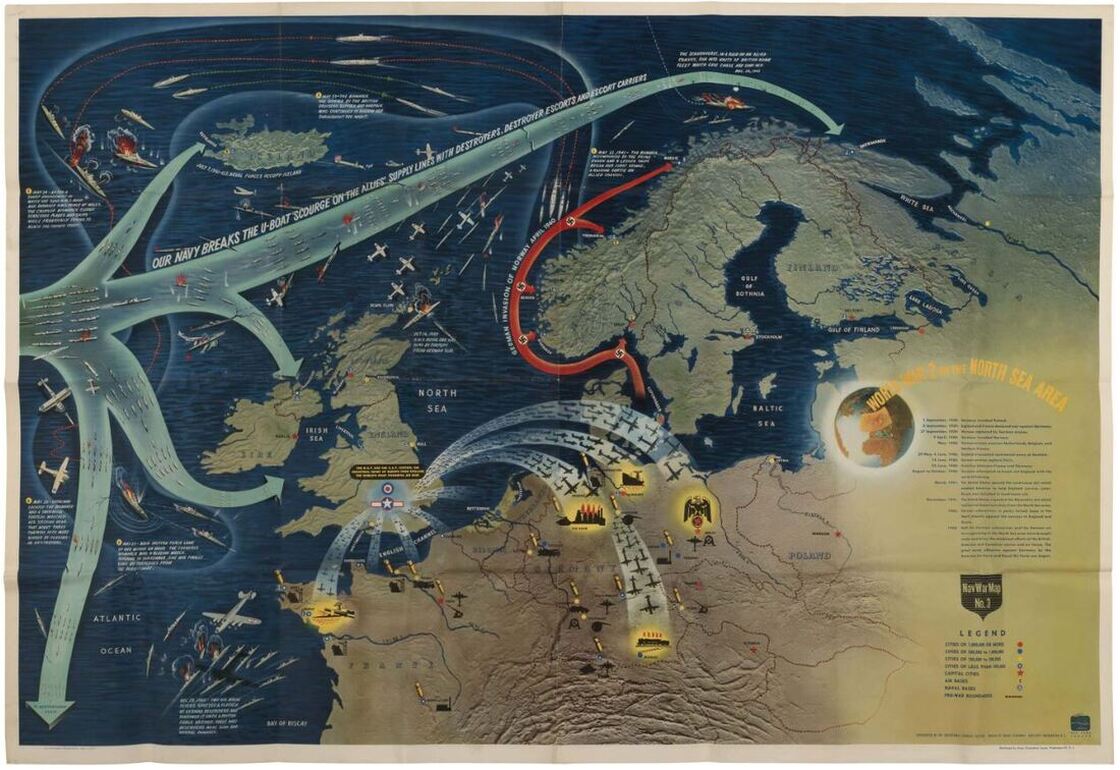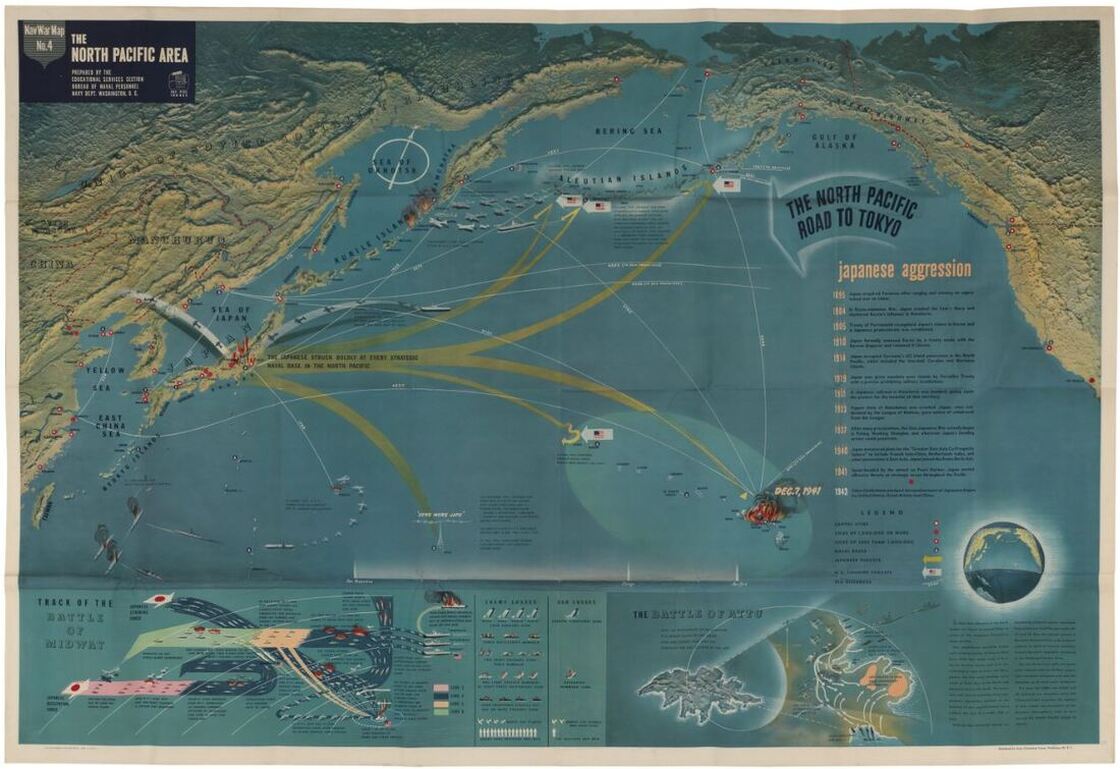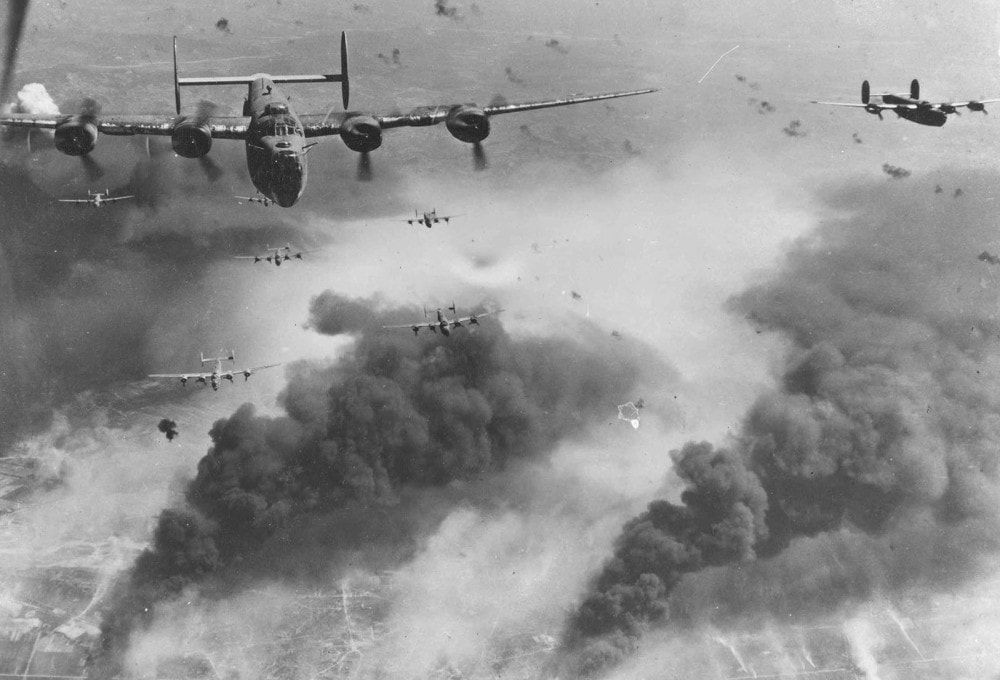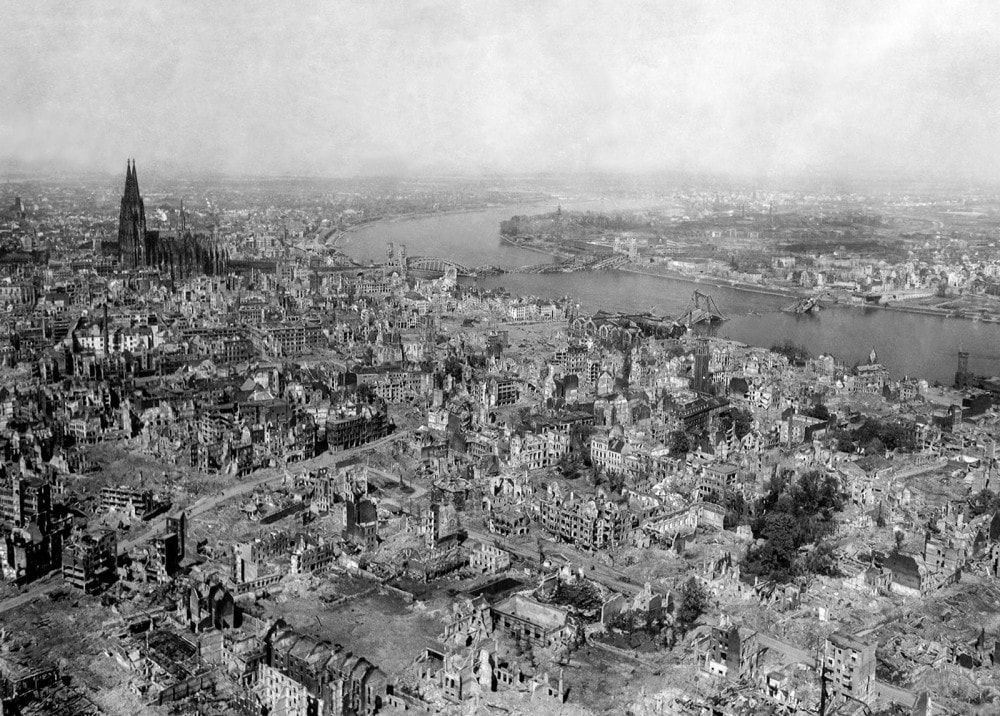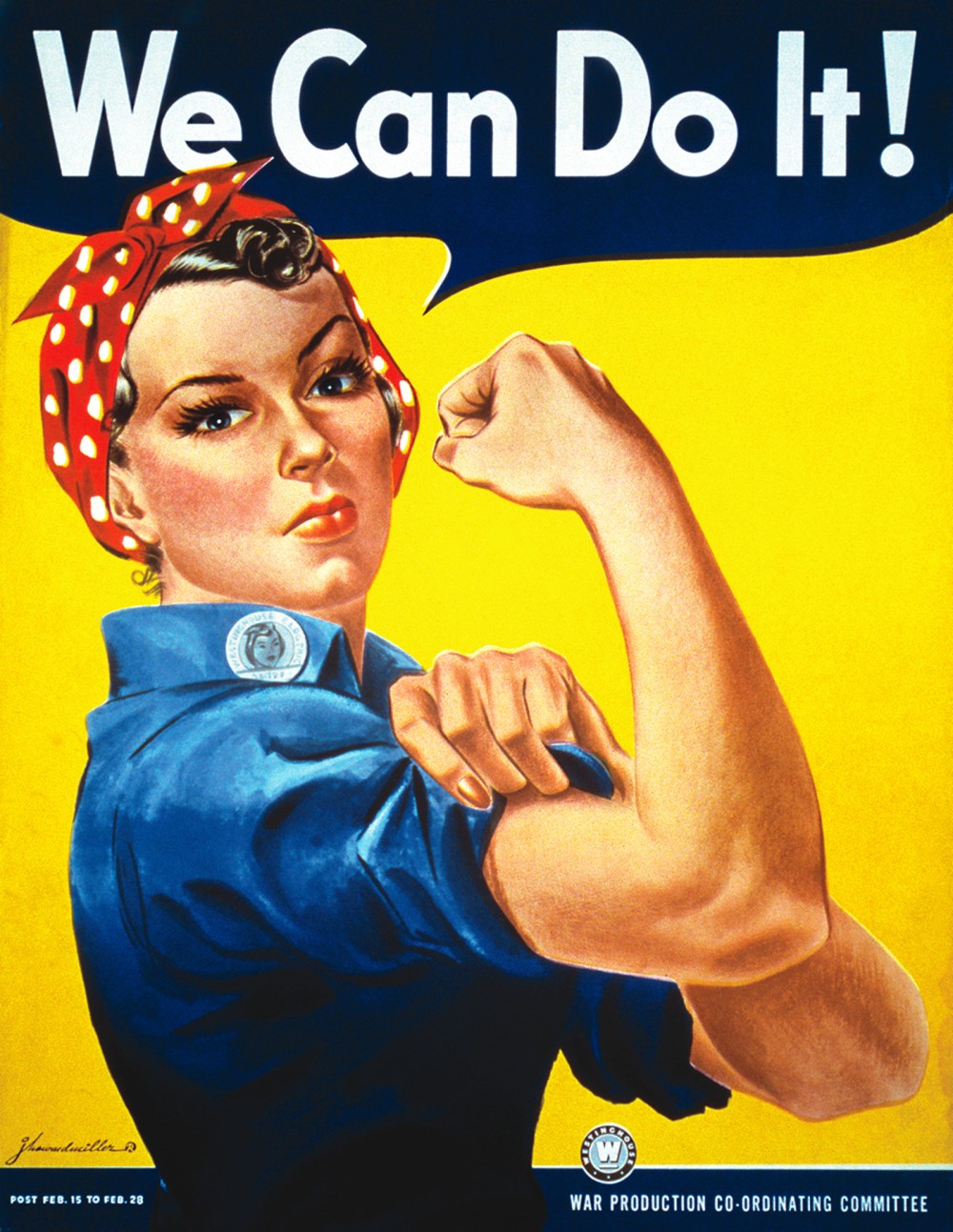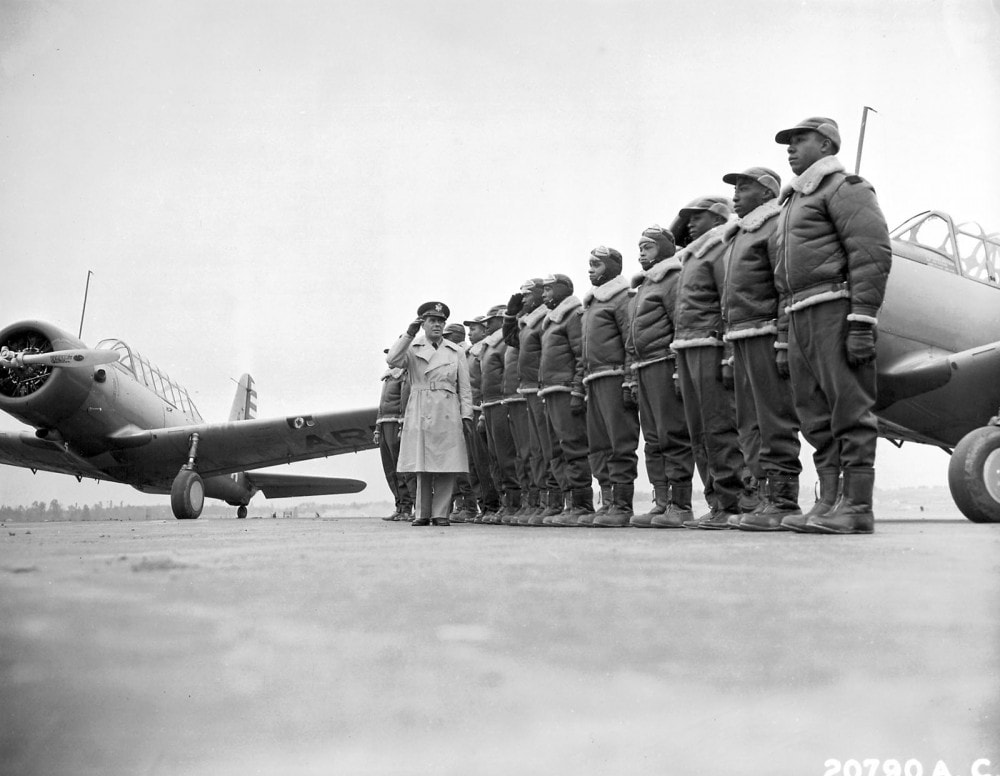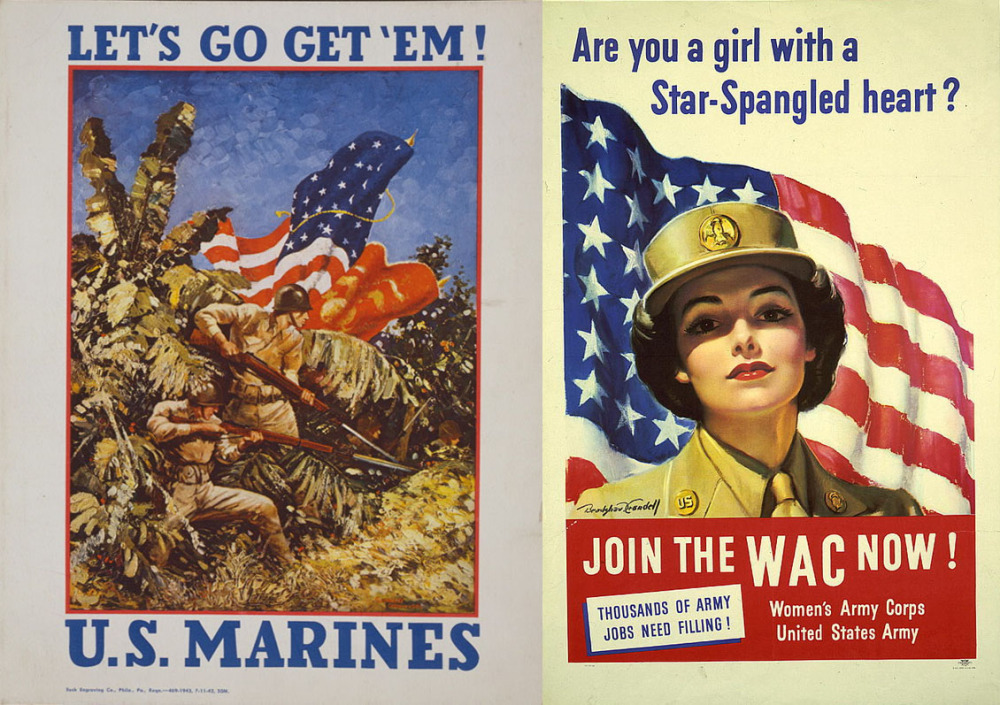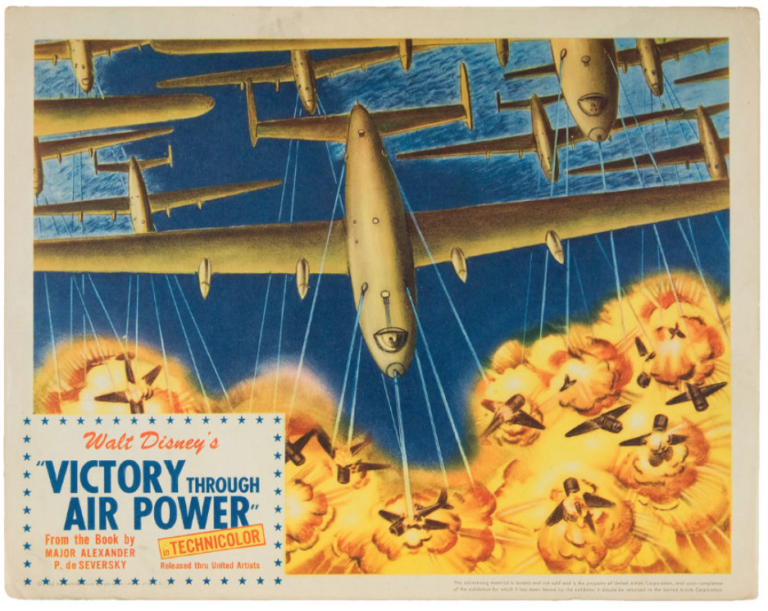The Second World War
1930s-1940s
Contents
The Second World War, 1930s-1940s:
WWII Before American Entry
|
The massive Nuremberg rallies, such as this one in 1935, instilled a fierce loyalty to (or fearful silence about) Hitler and the National Socialist Party in Germany. Wikimedia.
|
The German bombing of London left thousands homeless, hurt, or dead. This child, holding a stuffed toy, sits in the rubble as adults ponder their fate in the background. 1945. Library of Congress.
|
Review:
- Why did totalitarian states rise after World War I, and what did they do?
- How did Americans react to events in Europe and Asia in the early years of World War II?
WWII After Pearl Harbor
|
In 1943, Allied forces began a bombing campaign of railroad and oil targets in Bucharest, part of the wider policy of bombing expeditions meant to incapacitate German transportation. Bucharest was considered the number one oil target in Europe. Photograph, August 1, 1943. Wikimedia.
|
Bombings throughout Europe caused complete devastation in some areas, leveling beautiful ancient cities like Cologne, Germany. Cologne experienced an astonishing 262 separate air raids by Allied forces, leaving the city in ruins as in these the photograph above. Amazingly, the Cologne Cathedral stood nearly undamaged even after being hit numerous times, while the area around it crumbled. Photograph, April 24, 1945. Wikimedia.
|
Review:
- How did the US react to the Japanese attack on Pearl Harbor?
- How did the war change America at home?
- How did the Allies defeat the Axis Powers?
- How did the Holocaust develop and what were its results?
- What were the major immediate and long-term effects of World War II?
WWII Dates to Know:
This pair of U.S. military recruiting posters demonstrates the way that two branches of the military—the Marines and the Women’s Army Corps—borrowed techniques from professional advertisers to “sell” a romantic vision of war to Americans. One shows Marines at war in a lush jungle, reminding viewers that the war was taking place in exotic lands; the other depicted women taking on new jobs as a patriotic duty. Bradshaw Crandall, Are You a Girl with a Star-Spangled Heart? Recruiting Publicity Bureau, U.S. Women’s Army Corps Recruiting Poster (1943); Unknown, Let’s Go Get ’Em. Beck Engraving Co. (1942). Library of Congress.
Assignments and Readings
|
|
Your browser does not support viewing this document. Click here to download the document.
| ||||||
|
|
Your browser does not support viewing this document. Click here to download the document.
| ||||||
Debate on the Atomic Bombings
Your browser does not support viewing this document. Click here to download the document.
| debate_on_the_atomic_bombings.pdf | |
| File Size: | 92 kb |
| File Type: | |
Timeline of the Second World War
| timeline_of_the_second_world_war_worksheet.pdf | |
| File Size: | 192 kb |
| File Type: | |
Victory Through Air Power
| |||||||
Hiroshima: BBC History of World War II
| hiroshima.pdf | |
| File Size: | 75 kb |
| File Type: | |
Primary Sources
Charles A. Lindbergh, “America First” (1941)
Charles Lindbergh won international fame in 1927 after completing the first non-stop, solo flight across the Atlantic Ocean. As Hitler’s armies marched across the European continent, many Americans began to imagine American participation in the war. Charles Lindbergh and the America First Committee, advocating “America First,” championed American isolationism.
The Atlantic Charter (1941)
The leaders of the United States and United Kingdom signed the Atlantic Charter in August 1941. The short document neatly outlined an idealized vision for political and economic order of the postwar world.
FDR, Executive Order No. 9066 (1942)
During World War II, the federal government removed over 120,000 men, women, and children of Japanese descent (both foreign-born “issei” and native-born “nisei”) from the West Coast and interned in camps. President Roosevelt authorized the internments with his Executive Order No. 9066, issued on February 19, 1942.
Harry Truman Announcing the Atomic Bombing of Hiroshima (1945)
On August 6, 1945, Harry Truman disclosed to the American public that the United States had detonated an atomic bomb over Hiroshima, Japan.
Declaration of Independence of the Democratic Republic of Vietnam (1945)
Vietnam, which had been colonized by the French and then by the Japanese, declared their independence from colonial rule—particularly the re-imposition of a French colonial regime—in the aftermath of Japan’s defeat in World War II. Proclaimed by Ho Chi Minh in September 1945, Vietnam’s Declaration of Independence reflected back the early promises of the Allies in World War II and even borrowed directly from the American Declaration of Independence.
Tuskegee Airmen (1941)
The Tuskegee Airmen stand at attention as Major James A. Ellison returns the salute of Mac Ross, one of the first graduates of the Tuskegee cadets. The Tuskegee Airmen who continued a tradition of African American military service while honorably serving a country that still considered them second-class citizens.
World War II Recruitment Posters (1942 & 1943)
This pair of US Military recruiting posters demonstrates the way that two branches of the military—the Marines and the Women’s Army Corps—borrowed techniques from advertising professionals to “sell” a romantic vision of war to Americans. These two images take different strategies: one shows Marines at war in a lush jungle, reminding viewers that the war was taking place in exotic lands, the other depicted women taking on new jobs as a patriotic duty.
Charles Lindbergh won international fame in 1927 after completing the first non-stop, solo flight across the Atlantic Ocean. As Hitler’s armies marched across the European continent, many Americans began to imagine American participation in the war. Charles Lindbergh and the America First Committee, advocating “America First,” championed American isolationism.
The Atlantic Charter (1941)
The leaders of the United States and United Kingdom signed the Atlantic Charter in August 1941. The short document neatly outlined an idealized vision for political and economic order of the postwar world.
FDR, Executive Order No. 9066 (1942)
During World War II, the federal government removed over 120,000 men, women, and children of Japanese descent (both foreign-born “issei” and native-born “nisei”) from the West Coast and interned in camps. President Roosevelt authorized the internments with his Executive Order No. 9066, issued on February 19, 1942.
Harry Truman Announcing the Atomic Bombing of Hiroshima (1945)
On August 6, 1945, Harry Truman disclosed to the American public that the United States had detonated an atomic bomb over Hiroshima, Japan.
Declaration of Independence of the Democratic Republic of Vietnam (1945)
Vietnam, which had been colonized by the French and then by the Japanese, declared their independence from colonial rule—particularly the re-imposition of a French colonial regime—in the aftermath of Japan’s defeat in World War II. Proclaimed by Ho Chi Minh in September 1945, Vietnam’s Declaration of Independence reflected back the early promises of the Allies in World War II and even borrowed directly from the American Declaration of Independence.
Tuskegee Airmen (1941)
The Tuskegee Airmen stand at attention as Major James A. Ellison returns the salute of Mac Ross, one of the first graduates of the Tuskegee cadets. The Tuskegee Airmen who continued a tradition of African American military service while honorably serving a country that still considered them second-class citizens.
World War II Recruitment Posters (1942 & 1943)
This pair of US Military recruiting posters demonstrates the way that two branches of the military—the Marines and the Women’s Army Corps—borrowed techniques from advertising professionals to “sell” a romantic vision of war to Americans. These two images take different strategies: one shows Marines at war in a lush jungle, reminding viewers that the war was taking place in exotic lands, the other depicted women taking on new jobs as a patriotic duty.
Slideshows
Videos
|
|
|
|
|
|
|
|
|
Digital History Textbook
America at War: World War II
In this chapter, you will learn about the war’s causes, the Holocaust, the military history of the war, the impact of the war on women and racial and ethnic minorities, the internment of Japanese Americans, and the dawn of the atomic age.
Joe Louis
The Holocaust
World War II
Isolationism
The Coming of World War II
Conflict in the Pacific
Italy
Germany
War Begins
A Collision Course in the Pacific
Pearl Harbor
Mobilizing for War
Molding Public Opinion
Social Changes During the War
Italians, Germans, Japanese Aliens and European Jewry
Japanese-American Internment
The Military Conflict
The War in the Pacific
Controversy Continues
In this chapter, you will learn about the war’s causes, the Holocaust, the military history of the war, the impact of the war on women and racial and ethnic minorities, the internment of Japanese Americans, and the dawn of the atomic age.
Joe Louis
The Holocaust
World War II
Isolationism
The Coming of World War II
Conflict in the Pacific
Italy
Germany
War Begins
A Collision Course in the Pacific
Pearl Harbor
Mobilizing for War
Molding Public Opinion
Social Changes During the War
Italians, Germans, Japanese Aliens and European Jewry
Japanese-American Internment
The Military Conflict
The War in the Pacific
Controversy Continues
